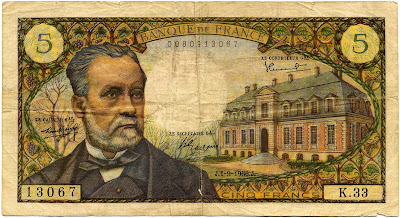I'm not a collector — I've never had enough — but I do have a few French franc notes left over from the earlier days when I lived in Paris. Or when I lived in California and came to France every year on vacation. They are just souvenirs.
One bill that I saved is a five-franc note. It was in circulation from 1966 until 1970, the year I spent a semester in Aix-en-Provence as a student. I turned 21 there. And talk about a starving student; I was. Somehow I managed to get back to the U.S. that summer with a five-franc note — the equivalent of one U.S. dollar.
This paper note was replaced by a 5 FF coin about 40 years ago.
I've had that five-franc note ever since. The man on it is Louis Pasteur, and the building is the Institut Pasteur in Paris. I have a friend whose apartment is very near there. There's also a Pasteur museum there, which I only recently heard of for the first time.
Another franc note I saved somewhere along the way is a billet worth 100 FF. It was the equivalent of our $20 bill in the U.S. I always liked the fact that French bank notes were different sizes — they got larger as their denomination went up. The 100 FF note is a lot bigger than the 5 FF note was, or the 10 FF note.
A Corneille/Rouen-themed French franc note from the 1970s
Sometime in the 1990s I was in a café in Paris with Walt and I pulled this bill out to pay for what we had consumed. I had found it in a drawer at home in San Francisco. The waiter looked at it wide-eyed. He was a young guy, and he said he didn't think he'd ever seen this particular bill before. In other words, it had gone out of circulation 20 years earlier. The waiter called it « un monument historique ». I don't know how it was that I ended up saving it all those years.
The man on the 100 FF note is the 17th century playwright Pierre Corneille. He was born and lived in Rouen in Normandy, where I lived for a year in 1972-73. I actually taught at the Lycée Corneille as an assistant d'anglais. The other images on the bill show the Rouen cathedral, the Seine river, and some other buildings.



Those old FFR bills were so pretty. Thanks for posting the pictures of them. The later ones a little less so. And the € bill -- well, they are certainly practical. Size increases with value. Both the €5 and €20 are blue, but the blue is not quite the same. €10 is reddish and €50 orange. €100 is bright green, if I remember correctly. Thank goodness the ATMs don't distribute bills over €50.
ReplyDeleteFurther to Ellen's comment re the Euro notes, I understand the €500 to be easy(ish) to counterfeit and so is the note of choice for money launderers and is hardly accepted by normal banks.
ReplyDeleteI think the 500 is easy to counterfeit simply because people usually haven't ever seen a real one. The ATMs here don't dispense anything but 10s and 20s. Even a 50 is a little bit of a nuisance to use in the shops here and if you have one it probably means you've been to the currency exchange.
ReplyDelete€50s are really hard to change. Unfortunately, the ATM nearest the market distributes only €50 notes. If I'm willing to wait for the traffic light to change and cross the street, there's a machine with €10s and €20s.
ReplyDeleteI think Susan is right, who has actually seen a €500 bill? For me, even €100 is rare. I think it was in Austria that the ATM gave us €100 bills that we asked the hotel to change for us.
The Pasteur museum has been on my wish list a few years and I almost got there on my last trip. It's good to save something for the next trip though.
ReplyDeleteI remember the 100 F note. Those blank white spots showed a picture when you held them up to the light, but I can't remember what the picture was- a person or a building maybe?
Vive Le Franc
ReplyDeleteOh, coooool, Ken! I love these old notes. I'm glad you ended up keeping the 100 FF note, with its symbolic Rouen theme :))
ReplyDeleteI definitely prefer the francs from that era -- I have one of these 10F notes with Voltaire on it (apparently originally issued in 1968). From a later trip, I have one of these of Saint-Exupery and Le Petit Prince.
And, look at this incredible one with Victor Hugo and the Pantheon!
(ooooh, I'm all excited that I just found that website)
Judy
Love the one with Hugo- I would love a print of it!
ReplyDeleteThanks for the link, Judy.
Ahhh, sweet memories.
ReplyDeleteI like that French bills honor men (and someday maybe women) from all endeavors. Unlike the U.S. where we just seem to go for dead presidents.
ReplyDeleteThere was a Pierre et Marie Curie bill back when there were still francs. And then La Semeuse and Marianne on the coins. I don't even know who is on the euro bills. Guess I should go look at some (if I have any lying around).
ReplyDeleteKen
ReplyDeleteFYI:
http://www.banque-france.fr/fr/instit/billets/gamme-echangeable.htm
http://www.banque-france.fr/fr/publications/revues/notes-d-information/telechar/note138.pdf
This comment has been removed by a blog administrator.
ReplyDeleteHello there! I just want to give you a big thumbs up for the excellent info you have here
ReplyDeleteon this post. I will be returning to your blog for more soon.